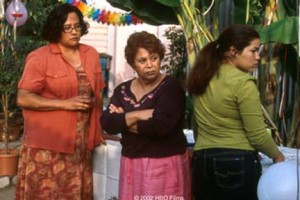Wizards of Waverly Place is a children’s television series that ran on Disney Channel from Fall 2007 to Winter 2012. The show focuses on the half Mexican/half Italian Russo family, owners of the Waverly Sub Station in New York City, who appear to be ordinary but have to hide the fact that they are wizards with magical abilities. The three siblings – Justin, Alex, and Max – have to prepare to compete against each other in the family wizard competition while grappling with typical issues of adolescence.
Wizards is the first Disney Channel Original Series to feature an interracial family. Three of the show’s actors (Maria Canals Barrera, Selena Gomez, and Jake T. Austin) have made positive contributions to the portrayal of Latina/os in the media, and have been nominated for several ALMA Awards for their work on the show. Wizards has won 3 Primetime Emmys for “Outstanding Children’s Program” in 2009, 2010, and 2012. The show ended as the longest-running Disney Channel Original Series with 106 episode over four seasons, and reached over 175 million unduplicated viewers in 163 countries and 32 languages. Disney Channel considers Wizards one of its most successful series ever.
In Quinceañera (Season 1, Episode 20), Teresa Russo is planning a quinceañera for her teenage daughter Alex. However, Alex – rough and rowdy, far from girly – does not want to have a quinceañera, and Jerry is not ready to accept that his daughter is growing up. I have provided you with the full episode for your viewing pleasure, and have pulled out a few scenes that demonstrate some of the themes we discussed in class:
- Mothers may play a more active role in planning the quinceañera
- Mothers may plan for a quinceañera as a way to live vicariously through their daughters
- Fathers may have trouble coping with the idea that their daughters are growing up
- Daughters may want to deviate from the traditional elements of a quinceañera
- Daughters may not feel as if they are the real focus of the quinceañera
- Families may tolerate greater financial charges than what is reasonable
Season 1, Episode 20: Quinceañera
[youtube http://www.youtube.com/watch?v=ZgPMVzrH4eY&w=480&h=360]
(4:00 – 4:09)
Teresa: “There are rituals symbolizing your becoming a woman, that you go through with your dad.”
Jerry: “What?! I didn’t give anybody permission to become a woman!”
(4:57 – 5:30)
Teresa: “There’s a ritual where you change from a flat shoe to a high heel shoe”
Alex: “Well, maybe I change from these high tops to even higher high tops”
Teresa: “No, Alex. There are certain things that people do at a quinceañera and we’re going to do them.”
Alex: “If I can’t wear my sneakers and I have to wear that [dress] then we’re not.”
Teresa: “Alex, you can’t just cancel, a lot of work has gone into this.”
Alex: “It’s my party, I can cancel if I want to.”
Teresa: “It’s not just your party, it’s OUR party.”
Alex: “Oh yeah, well it seems like it’s mostly just about you!”
(6:56 – 7:20)
Magdalena: “Well, I haven’t seen her this upset since she was fifteen and she asked if she could have a quinceañera, and we couldn’t afford it…maybe she figured at least she’d get to have one for you.”
(7:52 – 7:58)
Teresa: “I mean, it’s not like I have another daughter I can give my hopes and dreams to, you know?”
(14:47 – 14:56)
Jerry: “I will put these high heels on Alex to symbolize a girl becoming a woman.” [and begins to sob]
(21:14 – 22:00)
Jerry: “You really are growing up. You did all this for your mother, and look how happy it made her”
Alex: “I’m glad we did this too, dad.”
Jerry: “You really are turning into a wonderful woman, just like her. I’m so proud of you, honey.”
Alex: “Even when I break the rules and use magic behind your back?”
Jerry: “Even then. Oh, honey, are you crying?
Alex: “Yeah, but why aren’t you? You’ve been crying for days.”
Jerry: “Well I think I’m all cried out.”
Alex: “Really? What if I told you how much this quinceañera cost?”
Jerry: “OH MY GOSH! Here it comes again…” [and begins to sob loudly]






